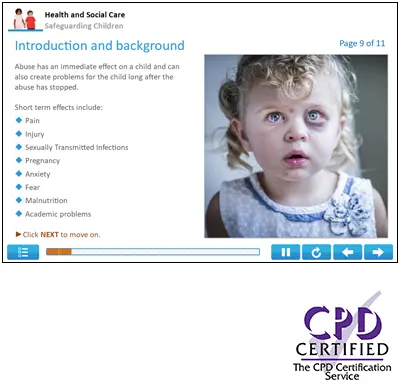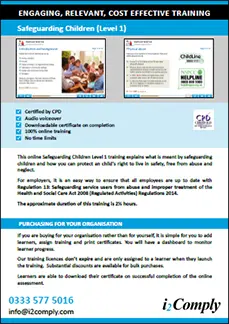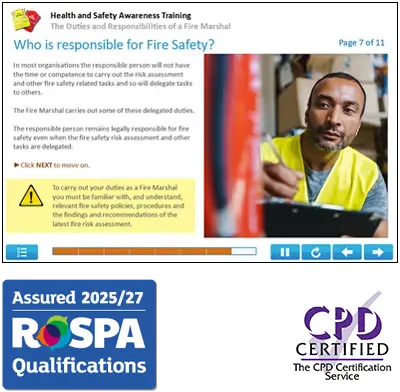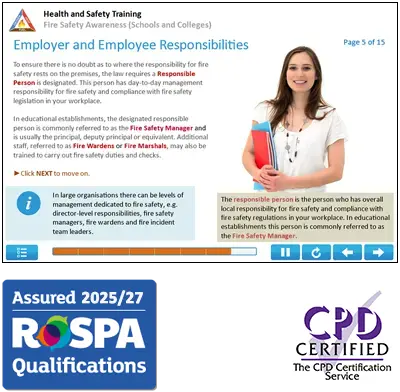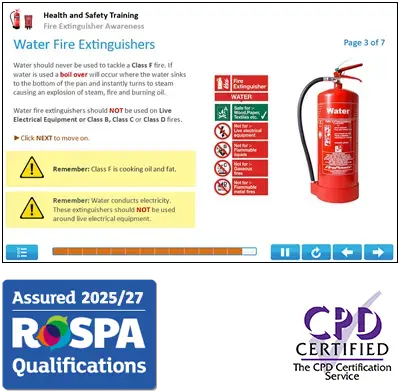Discounts Available For Bulk Purchases
| No. of total licenses |
% saving |
|---|---|
| 1 - 9 | - |
| 10 - 19 | 10% |
| 20 - 49 | 20% |
| 50 - 99 | 25% |
| 100 - 199 | 30% |
| 200 - 499 | 40% |
| 500 - 999 | 50% |
| 1000 + | 60% |
Safeguarding Children Level 1 Online Course
£17.50 + £3.50 VAT
- Certified by CPD
- Audio voiceover
- Approximate course duration 2 hours
- Downloadable certificate on completion
- 100% online training
Our online Introduction to safeguarding children course explains what is meant by safeguarding children. It explains how you can protect a child’s right to live in safety, free from abuse and neglect. If you work with children, completing this course will help improve your awareness of the potential dangers to children and the knowledge required to enhance their safety.
If you manage or employ staff members, our safeguarding children course is an easy way to ensure that all employees are up to date with Regulation 13: Safeguarding service users from abuse and improper treatment of the Health and Social Care Act 2008 (Regulated Activities) Regulations 2014.
Our course takes approximately 2 hours to complete. However, training progress is saved at the end of each topic, so you can complete the training in multiple sessions and take as long as you like.
Who is safeguarding children Level 1 training for?
This Introductory Safeguarding Children course is designed for anyone (including volunteers) who has infrequent contact with children, young people and/or parents/carers, but who may become aware of possible abuse or neglect.
Anyone who encounters children or young people should have safeguarding training and gain the necessary skills to confidently protect the children within their workplace and, in some cases, their personal life.
The training is often completed by librarians, GP and hospital receptionists and administrative staff, community advice centre staff, grounds staff, recreation assistants, environmental health officers.
Reviewed and approved by lead bodies
The training course complies with the Continuing Professional Development (CPD) guidelines and is accredited by the CPD Certification Service.
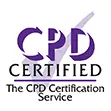
Course learning outcomes
After completing the safeguarding children course, you will be able to describe:
- Who is responsible for safeguarding children.
- Legislation that relates to safeguarding children.
- Several kinds of abuse that children can experience.
- Issues that make children vulnerable.
- What to do if a child discloses abuse or you suspect abuse.
Example course pages
See the images below for example screens from our safeguarding children online training course. The course contains easy-to-understand learning material, which will help you to effectively achieve the learning outcomes so that you can remain vigilant and know what to do if you suspect a child safeguarding issue at work or elsewhere.
(Click on the example screens below to view)
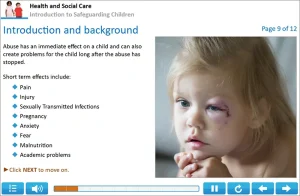
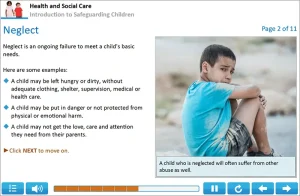
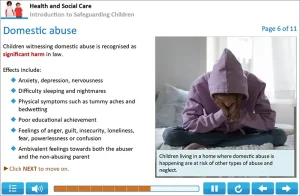
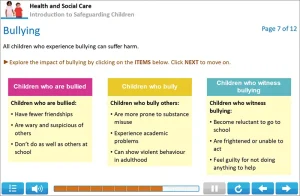
Course content
The online Safeguarding Children training course contains the following 11 topics:
1 – Introduction and background
The first topic outlines what safeguarding children means. It discusses who abuses children and who is responsible for safeguarding children. The topic also describes the impact of child abuse.
2 – Rights and legislation
The second topic identifies the rights of a child and outlines UK safeguarding law. The topic also covers what happens when abuse is reported
3 – About parents and carers
The third topic describes the impact of drugs and alcohol on parents and the impact of stress on the whole family. The topic also discusses parental mental health issues.
4 – Physical abuse
Topic 4 defines and describes physical abuse. It also identifies possible effects and some warning signs of abuse so you can spot a child in danger.
5 – Emotional abuse
Topic 5 outlines emotional abuse, including the impact of this type of abuse and signs that it might be taking place.
6 – Sexual abuse
Topic 6 is about sexual abuse. It also describes the impact and warning signs of this type of abuse.
7 – Neglect
Topic 7 provides a definition of neglect. It also identifies different types of neglect.
8 – Domestic abuse
Topic 8 describes domestic abuse, including the prevalence, impact and warning signs of this type of abuse.
9 – Bullying
Topic 9 defines what constitutes bullying and outlines the prevalence, impact and warning signs of bullying.
10 – Special issues around disabled children
Topic 10 outlines the higher risk of abuse for disabled children. It also describes the impact of communication barriers and isolation. It also explains how the signs of abuse of disabled children can be missed.
11 – What to do about abuse
The final topic explains how to deal with disclosure and how to record facts of disclosure. It also explains how to report abuse.
Course assessment
At the end of the course, there is an assessment. We generate the assessment from question banks, so the questions are different each time you participate. The training is helpful for initial training and as a refresher to child safeguarding.
You get feedback for each question so you can learn from incorrect responses, and there is no limit on the number of attempts you can have.
Course certificate
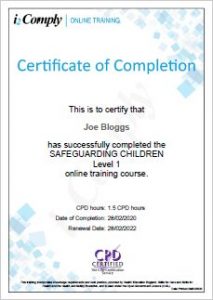
After successfully passing the online safeguarding children course, you can download and print your certificate immediately. Your certificate will include the CPD logo and therefore, you can use it to provide evidence for compliance.
How long is my safeguarding children course certificate valid for?
Your Safeguarding Children course certificate will not expire. However, to ensure your knowledge of children safeguarding is still current, we recommend refreshing the course after 3 years from completion. This recommended renewal date will be printed on your certificate.
Course reviews
Before you decide whether our Safeguarding Children online training course is what you are looking for, read our Safeguarding Children Course Reviews.
For us to keep improving our courses we require your feedback. Please take a couple of minutes and leave a review on Reviews.io or leave a review on Google, we would really appreciate it.
What does safeguarding children mean?
Safeguarding children is the process of promoting the welfare of children and protecting them from harm. This includes all procedures designed to prevent injury to a child, including taking actions to protect children from maltreatment, abuse, and neglect, preventing damage to their health or development, ensuring that children receive safe and effective care and taking action to enable all children to have the best outcomes and equal opportunities in life.
Why safeguarding children training is important
Everyone working closely with children or young people within an organisation is responsible for protecting them from abuse and neglect.
An essential part of safeguarding is being able to identify children who are at risk. Any child can be in danger of abuse, and everyone reacts differently. Knowing what signs to look out for is vital in allowing you to intervene, preventing further abuse and getting the child the safety and support they need.
All staff must have up-to-date safeguarding children training. Trained staff are more confident in situations they might be presented with and more able to take the decisive action necessary.
Sometimes it is up to you to spot the right signs and take the necessary action. This online course will improve your awareness of these signs.
Why online training is the best option
Online training methods come with many benefits regarding a child safeguarding course. Here are the biggest:
- No time limits; take as long as you like to read the content before starting the course assessment.
- If you have many staff members completing the safeguarding children course, you can rest assured that they all receive identical training resources.
- No need for travel, save money on trains and petrol.
- Online training courses are an affordable option. £15 per employee means you could afford to train more staff members for less.
- Everyone completing this course will have different looking work schedules. Online training means they can study at a time which suits their schedules.
Book our online safeguarding children course today
Once you are ready to purchase Safeguarding Children online course, simply add the course to your basket by clicking the Add to Basket button and proceed to checkout.
If you would like to purchase for your team, don’t forget to take advantage of our bulk purchase discounts. You can see a list of available discounts at the left hand side of the page. Discounts are automatically applied at checkout.
Other online UK Health & Social Care courses
Click on the course titles below to learn about other Health & Social Care courses or see a full list of courses here.
- Dementia Awareness Training Course
- Infection Prevention and Control Course
- Safeguarding Adults Course (Level 2)
- The Legal Use of Restrictive Interventions Course
Want to view our entire course offerings? View our training courses on fire safety, health and safety, food hygiene and health & social care.
Any additional questions on the course?
Even after reading all the relevant information and answers to questions regarding our safeguarding children training above, you might have some other queries. If so, contact one of our experts by emailing support@i2comply.com or call 0333 5775 017.
We also have a resource centre available to answer FAQs. Please see what questions we’ve previously answered, including replies to questions regarding licences, account settings, discounts, payment options and more.
Request an online training quote
Whether you are looking to train a small team or an entire business, we’re here to help. Let us know your online training requirements and we’ll provide you with a quote.
£17.50 + £3.50 VAT
Discounts Available For Bulk Purchases
| No. of total licenses |
% saving |
|---|---|
| 1 - 9 | - |
| 10 - 19 | 10% |
| 20 - 49 | 20% |
| 50 - 99 | 25% |
| 100 - 199 | 30% |
| 200 - 499 | 40% |
| 500 - 999 | 50% |
| 1000 + | 60% |
